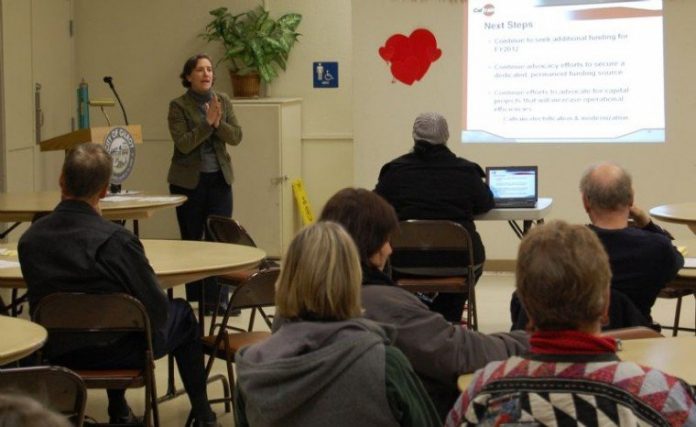South Santa Clara County residents looking for answers at a
Caltrain community meeting Thursday night didn’t get what they were
after. Residents and concerned riders threw one question after
another at Michelle Bouchard, Caltrain’s deputy director of rail
operations, during a 90-minute presentation at the Gilroy Senior
Center, but were rebutted with a similar response each time.
South Santa Clara County residents looking for answers at a Caltrain community meeting Thursday night didn’t get what they were after.
About 50 residents and concerned riders threw one question after another at Michelle Bouchard, Caltrain’s deputy director of rail operations, during a 90-minute presentation at the Gilroy Senior Center, but were rebutted with a similar response each time.
“I can’t answer that,” Bouchard replied, adding she would take residents’ concerns back to top officials at Caltrain, which recently announced it expected to face a $30 million budget shortfall.
Jason Gentry, a building inspector for the city of Santa Clara, said Caltrain officials listened to residents’ ideas last year but little was done to implement their concerns.
“What happened to all our comments?” he said. “Nothing was ever done. The mentality is ‘Screw South County.’ Pardon my French.”
Gentry said he didn’t feel as though any progress was being made.
“We knew we had a problem a year ago,” he said.
Residents at the meeting wanted to know a number of things. Why are stations in Morgan Hill, San Martin and Gilroy on the chopping block, and, if funding is secured, would those stations be brought back first? Would it save money to run fewer or shorter trains? Is it possible for Caltrain to merge with its lone three sources of funding – the City and County of San Francisco, the San Mateo County Transit District and the Santa Clara Valley Transportation Authority?
Caltrain Public Information Officer Tasha Bartholomew said some questions couldn’t be remedied Thursday night because she and Bouchard simply didn’t have answers.
“It’s frustrating at times. People have concerns,” Bartholomew said. “It’s still important for us to hear from our ridership. Our job is to take their concerns back with us.”
If it can’t come up reliable funding, Caltrain could reduce from 86 weekday trains to just 48, cut service on weekends and holidays and eliminate stations south of San Jose, Bouchard said.
Even then, Caltrain would still run a $4.7 million deficit, she said, and the organization may end up declaring a fiscal emergency.
The Gilroy, San Martin and Morgan Hill trains do not run on the weekends.
Any proposed service reduction didn’t sit right with Morgan Hill resident Swanee Edwards.
“We really get dumped on in South County,” she said.
Caltrain might also increase its base fare by 25 cents and enact daily and monthly parking rate increases, Bouchard said.
Bouchard also said there would a public hearing regarding the budget during Caltrain’s next board meeting March 3 at the Edward J. Bacciocco Auditorium, located on the second floor at the SamTrans Administrative Offices at 1250 San Carlos Ave. in San Carlos.
Caltrain’s new fares and service schedule would be implemented by July 2, she added.
Chris Lepe, the Silicon Valley community planner for Bay Area public transportation advocacy group TransForm, said the Caltrain cuts weren’t inevitable.
“The more the public starts realizing what could happen to Caltrain, more people will start being concerned,” he said. “There’s a lot of hope in that respect.”














